Spatiotemporal Variation in Soil Wind Erosion in the Northern Slope of the Tianshan Mountains from 2000 to 2018
Abstract
1. Introduction
2. Materials and Methods
2.1. Study Area
2.2. Data Sources
2.3. Revised Wind Erosion Equation
2.4. Classification of Soil Wind Erosion Intensity
2.5. Statistical Analysis
2.5.1. Mann–Kendall Trend Test
2.5.2. Spearman’s Correlation Coefficient ()
2.5.3. Land Use Transition Matrix
2.5.4. Geodetector
3. Results
3.1. Spatial Distribution Pattern of Soil Wind Erosion in the NSTM
3.2. Temporal Dynamics of Soil Wind Erosion in the NSTM
3.3. Spatiotemporal Trends of Soil Wind Erosion in the NSTM
4. Discussion
4.1. The Reliability of This Study
4.2. The Drivers of Soil Wind Erosion in the NSTM
4.2.1. The Impact of Wind Factor on Soil Wind Erosion
4.2.2. The Impact of Land Use on the Soil Wind Erosion
4.2.3. Interaction of Influencing Factors of Soil Wind Erosion
4.3. Limitation of This Study
5. Conclusions
Author Contributions
Funding
Data Availability Statement
Conflicts of Interest
References
- Lal, R. Soil Erosion and the Global Carbon Budget. Environ. Int. 2023, 29, 437–450. [Google Scholar] [CrossRef] [PubMed]
- Field, J.P.; Belnap, J.; Breshears, D.D.; Neff, J.C.; Okin, G.S.; Whicker, J.J.; Painter, T.H.; Ravi, S.; Reheis, M.C.; Reynolds, R.L. The Ecology of Dust. Front. Ecol. Environ. 2010, 8, 423–430. [Google Scholar] [CrossRef]
- Qian, W.H.; Quan, L.S.; Shi, S.Y. Variations of the Dust Storm in China and its Climatic Control. J. Clim. 2002, 15, 1216–1229. [Google Scholar] [CrossRef]
- Buschiazzo, D.E.; Zobeck, T.M. Validation of WEQ, RWEQ and WEPS Wind Erosion for Different Arable Land Management Systems in the Argentinean Pampas. Earth. Surf. Process. Landf. 2008, 33, 1839–1850. [Google Scholar] [CrossRef]
- Chepil, W.S. Dynamics of Wind Erosion: I. Nature of Movement of Soil by Wind. Soil Sci. 1945, 60, 305–320. [Google Scholar] [CrossRef]
- Du, H.D.; Jiao, J.Y.; Jia, Y.F.; Wang, N.; Wang, D.L. Phytogenic Mounds of Four Typical Shoot Architecture Species at Different Slope Gradients on the Loess Plateau of China. Geomorphology 2013, 193, 57–64. [Google Scholar] [CrossRef]
- Wu, Z.T.; Wang, M.Y.; Zhang, H.; Du, Z.Q. Vegetation and Soil Wind Erosion Dynamics of Sandstorm Control Programs in the Agro-Pastoral Transitional Zone of Northern China. Front. Earth Sci. 2019, 13, 430–443. [Google Scholar] [CrossRef]
- Yin, Z.C.; Wan, Y.; Zhang, Y.J.; Wang, H.J. Why super sandstorm 2021 in North China. Natl. Sci. Rev. 2021, 9, nwab165. [Google Scholar] [CrossRef]
- Cook, B.I.; Miller, R.L.; Seager, R. Dust and Sea Surface Temperature Forcing of the 1930s “Dust Bowl” Drought. Geophys. Res. Lett. 2008, 35, 114–118. [Google Scholar] [CrossRef]
- Copeland, N.S.; Sharratt, B.S.; Wu, J.Q.; Foltz, R.B.; Dooley, J.H. A Wood-Strand Material for Wind Erosion Control: Effects on Total Sediment Loss, PM10 Vertical Flux, and PM10 Loss. J. Environ. Qual. 2009, 38, 139–148. [Google Scholar] [CrossRef]
- Bartkowski, B.; Schepanski, K.; Bredenbeck, S.; Müller, B. Wind Erosion in European Agricultural Landscapes: More than Physics. People Nat. 2023, 5, 34–44. [Google Scholar] [CrossRef]
- Furieri, B.; Russeil, S.; Santos, J.M.; Harion, J.L. Effects of Non-Erodible Particles on Aeolian Erosion: Wind-Tunnel Simulations of a Sand Oblong Storage Pile. Atmos. Environ. 2013, 79, 672–680. [Google Scholar] [CrossRef]
- Giménez, A.; Lozano, F.J.; Torres, J.A.; Asensio, C. Automated System for Soil Wind Erosion Studies. Comput. Electron. Agric. 2019, 164, 104889. [Google Scholar] [CrossRef]
- Liu, J.Y.; Qi, Y.Q.; Shi, H.D.; Zhuang, D.F.; Hu, Y.F. Estimation of Wind Erosion Rates by Using 137 Cs Tracing Technique: A Case Study in Tariat-Xilin Gol Transect, Mongolian Plateau. Chin. Sci. Bull. 2008, 53, 751–758. [Google Scholar] [CrossRef]
- Jarrah, M.; Mayel, S.; Tatarko, J.; Funk, R.; Kuka, K. A Review of Wind Erosion Models: Data Requirements, Processes, and Validity. Catena 2020, 187, 104388. [Google Scholar] [CrossRef]
- Woodruff, N.P.; Siddoway, F.H. A Wind Erosion Equation. Soil Sci. Soc. Am. J. 1965, 29, 602–608. [Google Scholar] [CrossRef]
- Williams, J.R.; Jones, C.A.; Dyke, P.T. A Modeling Approach to Determining the Relationship Between Erosion and Soil Productivity. Trans. ASAE. 1984, 27, 129–144. [Google Scholar] [CrossRef]
- Hagen, L.J. A Wind Erosion Prediction System to Meet User Needs. J. Soil Water Conserv. 1991, 46, 106–111. [Google Scholar]
- Fryrear, D.W.; Chen, W.N.; Lester, C. Revised Wind Erosion Equation. Ann. Arid Zone 2001, 40, 265–279. [Google Scholar]
- Gregory, J.; Wilson, G.; Singh, U.; Darwish, M. TEAM: Integrated, Process-Based Wind-Erosion Model. Environ. Model. Softw. 2004, 19, 205–215. [Google Scholar] [CrossRef]
- Tatarko, J.; Wagner, L.; Fox, F. The Wind Erosion Prediction System and Its Use in Conservation Planning. In Bridging Among Disciplines by Synthesizing Soil and Plant Processes; Wendroth, O., Lascano, R.J., Ma, L., Eds.; American Society of Agronomy, Inc., Soil Science Society of America, Inc., Crop Science Society of America, Inc.: Madison, WI, USA, 2019; Volume 8, pp. 71–101. [Google Scholar]
- Mandakh, N.; Tsogtbaatar, J.; Dash, D.; Khudulmur, S. Spatial assessment of soil wind erosion using WEQ approach in Mongulia. J. Geographic.Sci. 2016, 26, 473–483. [Google Scholar] [CrossRef]
- Liu, J.; Guo, Z.L.; Chang, C.P.; Wang, R.D.; Li, J.F.; Li, Q.; Wang, X.Y. Potential Wind Erosion Simulation in the Agro-Pastoral Ecotone of Northern China Using RWEQ and WEPS Models. J. Desert Res. 2021, 41, 27–37. (In Chinese) [Google Scholar] [CrossRef]
- Ma, Y.L.; Wang, Z.D.; Zhang, J.Q.; Xu, Y.S.; Li, Y.Y. Effect of Moss Crust Coverage and Spatial Distribution on Soil Wind Erosion Using Wind Tunnel Experiments and Simulations. J. Desert Res. 2023, 43, 97–107. (In Chinese) [Google Scholar] [CrossRef]
- Gong, G.L.; Liu, J.Y.; Shao, Q.Q. Effects of Vegetation Coverage Change on Soil Conservation Service of Typical Steppe in Inner Mongolia. Geo-Inf. Sci. 2014, 16, 426–434. (In Chinese) [Google Scholar]
- Gong, G.L.; Liu, J.Y.; Shao, Q.Q. Wind erosion in Xilingol League, Inner Mongolia since the 1990s using the Revised Wind Erosion Equation. Prog. Geogr. 2014, 33, 825–834. (In Chinese) [Google Scholar] [CrossRef]
- Gong, G.L.; Liu, J.Y.; Shao, Q.Q.; Zhai, J. Sand-Fixing Function under the Change of Vegetation Coverage in a Wind Erosion Area in Northern China. J. Resour. Ecol. 2014, 5, 105–114. (In Chinese) [Google Scholar] [CrossRef]
- Jiang, L.; Xiao, Y.; Ouyang, Z.Y.; Xu, W.H.; Zhen, H. Estimate of the Wind Erosion Modulus in Qinghai Province Based on RWEQ Model. Res. Soil Water Conserv. 2015, 22, 21–25+32+2. (In Chinese) [Google Scholar] [CrossRef]
- Jiang, L.; Xiao, Y.; Zheng, H.; Ouyang, Z.Y. Spatio-Temporal Variation of Wind Erosion in Inner Mongolia of China between 2001 and 2010. Chin. Geogr. Sci. 2016, 26, 155–164. [Google Scholar] [CrossRef]
- Shen, L.; Tian, M.R.; Gao, J.X.; Qian, J.P. Spatio-Temporal Change of Sand-Fixing Fuction and Its Driving Forces in Desertification Control Ecological Function Area of Hunshandake, China. Chin. J. Appl. Ecol. 2016, 27, 73–82. (In Chinese) [Google Scholar] [CrossRef]
- Shen, L.; Tian, M.R.; Gao, J.X. Analysis on Wind Erosion and Main Factors in Desertification Control Ecological Function Area of Hunshandake Using the Revised Wind Erosion Equation Model. Res. Soil Water Conserv. 2016, 23, 90–97. (In Chinese) [Google Scholar] [CrossRef]
- Zhang, L.; Guo, Z.L.; Li, J.F.; Chang, C.P.; Wang, R.D.; Li, Q. Effect of the Type of Wind Data on Regional Potential Wind Erosion Estimation. Front. Environ. Sci. 2022, 10, 847128. [Google Scholar] [CrossRef]
- Du, H.Q.; Zuo, X.A.; Li, S.; Wang, T.; Xue, X. Wind Erosion Changes Induced by Different Grazing Intensities in the Desert Steppe, Northern China. Agric. Ecosyst. Environ. 2019, 274, 1–13. [Google Scholar] [CrossRef]
- Li, D.J.; Xu, E.Q.; Zhang, H.Q. Influence of Ecological Land Change on Wind Erosion Prevention Service in Arid Area of Northwest China from 1990 to 2015. Ecol. Indic. 2020, 117, 106686. [Google Scholar] [CrossRef]
- Guo, Z.Q.; Yan, Z.J.; He, R.; Yang, H.; Ci, H.; Wang, R. Impacts of Land Use Conversion on Soil Erosion in the Urban Agglomeration on the Northern Slopes of the Tianshan Mountains. Land 2024, 13, 550. [Google Scholar] [CrossRef]
- Wei, W.Y.; Liu, Y.; Zhang, L.X.; Li, L.H. Distribution Assessment of Soil Erosion with Revised RUSLE Model in Tianshan Mountains. J. Mt. Sci. 2024, 21, 850–866. [Google Scholar] [CrossRef]
- Zhang, X.Y.; Wu, S.X. Spatial-temporal Dynamics of Desertification in Typical Region of Oasis to Desert in Northern Piedmont of Tianshan Mountains. J. Desert Res. 2006, 26, 208–214. (In Chinese) [Google Scholar]
- Tang, Q.H.; Liu, X.C.; Zhou, Y.Y.; Wang, P.Y.; Li, Z.Q.; Hao, Z.X.; Liu, S.X.; Zhao, G.; Zhu, B.Q.; He, X.L.; et al. Climate Change and Water Security in the Northern Slope of the Tianshan Mountains. Geo. Sus. 2022, 3, 246–257. [Google Scholar] [CrossRef]
- He, J.; Yang, K.; Tang, W.J.; Lu, H.; Qin, J.; Chen, Y.Y.; Li, X. The First High-Resolution Meteorological Forcing Dataset for Land Process Studies over China. Sci. Data 2020, 7, 25. [Google Scholar] [CrossRef]
- Yang, K.; He, J.; Tang, W.J.; Qin, J.; Cheng, C.C.K. On Downward Shortwave and Longwave Radiations over High Altitude Regions: Observation and Modeling in the Tibetan Plateau. Agric. For. Meteorol. 2010, 150, 38–46. [Google Scholar] [CrossRef]
- Peng, S.Z.; Ding, Y.X.; Wen, Z.M.; Chen, Y.M.; Cao, Y.; Ren, J.Y. Spatiotemporal Change and Trend Analysis of Potential Evapotranspiration over the Loess Plateau of China during 2011-2100. Agric. For. Meteorol. 2017, 233, 183–194. [Google Scholar] [CrossRef]
- Ding, Y.X.; Peng, S.Z. Spatiotemporal Trends and Attribution of Drought across China from 1901–2100. Sustainability 2020, 12, 477. [Google Scholar] [CrossRef]
- Ding, Y.X.; Peng, S.Z. Spatiotemporal Change and Attribution of Potential Evapotranspiration over China from 1901 to 2100. Theor. Appl. Climatol. 2021, 145, 79–94. [Google Scholar] [CrossRef]
- Peng, S.Z.; Ding, Y.X.; Liu, W.Z.; Li, Z. 1 Km Monthly Temperature and Precipitation Dataset for China from 1901 to 2017. Earth Syst. Sci. Data 2019, 11, 1931–1946. [Google Scholar] [CrossRef]
- Che, T.; Li, X.; Jin, R.; Armstrong, R.; Zhang, T.J. Snow depth derived from passive microwave remote-sensing data in China. Ann. Glaciol. 2008, 49, 145–154. [Google Scholar] [CrossRef]
- Dai, L.Y.; Che, T.; Ding, Y.J. Inter-calibrating SMMR, SSM/I and SSMI/S data to improve the consistency of snow-depth products in China. Remote Sens. 2015, 7, 7212–7230. [Google Scholar] [CrossRef]
- Dai, L.Y.; Che, T.; Ding, Y.J.; Hao, X.H. Evaluation of snow cover and snow depth on the Qinghai–Tibetan Plateau derived from passive microwave remote sensing. Cryosphere 2017, 11, 1933–1948. [Google Scholar] [CrossRef]
- Fischer, G.; Nachtergaele, F.; Prieler, S.; van Velthuizen, H.T.; Verelst, L.; Wiberg, D. Global Agro-Ecological Zones Assessment for Agriculture (GAEZ 2008); IIASA: Laxenburg, Austria; FAO: Rome, Italy, 2008. [Google Scholar]
- China Meteorological Forcing Dataset (1979–2018). Available online: https://data.tpdc.ac.cn/en/data/8028b944-daaa-4511-8769-965612652c49 (accessed on 20 November 2023).
- 1 km Monthly Potential Evapotranspiration Dataset in China (1901–2023). Available online: https://loess.geodata.cn/data/datadetails.html?dataguid=34595274939620&docid=74 (accessed on 20 November 2023).
- Long-Term Series of Daily Snow Depth Dataset in China (1979–2023). Available online: https://data.tpdc.ac.cn/en/data/df40346a-0202-4ed2-bb07-b65dfcda9368/ (accessed on 20 November 2023).
- Chinese Soil Dataset Based on the World Soil Database (HWSD) (v1.1). Available online: http://www.ncdc.ac.cn/portal/metadata/a948627d-4b71-4f68-b1b6-fe02e302af09 (accessed on 20 November 2023).
- China Monthly 250 m Vegetation Index (NDVI) Spatial Distribution Data Set. Available online: https://www.resdc.cn/DOI/DOI.aspx?DOIid=50 (accessed on 20 November 2023).
- The 30 m Annual Land Cover Datasets and Its Dynamics in China from 1990 to 2021. Available online: https://zenodo.org/records/5816591 (accessed on 20 November 2023).
- Fryrear, D.W.; Bilbro, J.D.; Saleh, A.; Schomberg, H.; Stout, J.E.; Zobeck, T.M. RWEQ: Improved wind erosion technology. J. Soil Water Conserv. 2000, 55, 183–189. [Google Scholar]
- Hargreaves, G.H.; Samani, Z.A. Estimating Potential Evapotranspiration. J. Irrig. Drain. Div. 1982, 108, 225–230. [Google Scholar] [CrossRef]
- Saleh, A. Soil Roughness Measurement: Chain Method. J. Soil Water Conserv. 1993, 48, 527–529. [Google Scholar]
- Li, J.; You, S.C.; Huang, J.F. Spatial Distribution of Ground Roughness Length Based on GIS in China. J. Shanghai Jiaotong Univ. Sci. 2006, 24, 185–189. (In Chinese) [Google Scholar]
- Shang, R.Y.; Qi, Y.X.; Zhao, T.N.; Ding, G.D. Field Investigation on the Influence of Vegetation on Wind and Soil Erosion. Res. Soil Water Conserv. 2006, 13, 37–39. (In Chinese) [Google Scholar]
- SL190-2007; Standards for Classification and Gradation of Soil Erosion. Ministry of Water Resources of the People’s Republic of China: Beijing, China, 2008. (In Chinese)
- Gocic, M.; Trajkovic, S. Analysis of Changes in Meteorological Variables Using Mann-Kendall and Sen’s Slope Estimator Statistical Tests in Serbia. Glob. Planet Chang. 2013, 100, 172–182. [Google Scholar] [CrossRef]
- Xiao, C.; Ye, J.; Esteves, R.M.; Rong, C. Using Spearman’s Correlation Coefficients for Exploratory Data Analysis on Big Dataset. Concurr. Comput. 2016, 28, 3866–3878. [Google Scholar] [CrossRef]
- Liu, R.; Zhu, D.L. Methods for Detecting Land Use Changes Based on the Land Use Transition Matrix. Resour. Sci. 2010, 32, 1544–1550. (In Chinese) [Google Scholar]
- Wang, J.F.; Xu, C.D. Geodetector: Principle and prospective. Acta Geogr. Sin. 2017, 72, 116–134. (In Chinese) [Google Scholar] [CrossRef]
- Cai, D.W. Desertification Processes and their Response to Climate Change in Central Asia. Ph.D. Thesis, University of Chinese Academy of Sciences, Beijing, China, 2022. (In Chinese). [Google Scholar]
- Wu, F.F. Research of Soil Wind Erosion in Zhundong Areas Based on Wind Erosion Model. Master’s Thesis, Xinjiang University, Urumqi, China, 2018. (In Chinese). [Google Scholar]
- Zhang, Q.Q.; Gu, F.; Zhang, S.C.; Chen, X.H.; Ding, X.; Xu, Z.L. Spatiotemporal Variation in Wind Erosion in Tarim River Basin from 2010 to 2018. Land 2024, 13, 330. [Google Scholar] [CrossRef]
- Ding, Z.L.; Wang, J.; Xu, P.H.; Cao, Y.E.; Liu, W.; Yang, J.J. Using 137Cs Technique to Study Soil Wind Erosion of Different Land Use Types in Eastern Junggar Basin, Xinjiang. Soils 2018, 50, 398–403. (In Chinese) [Google Scholar] [CrossRef]
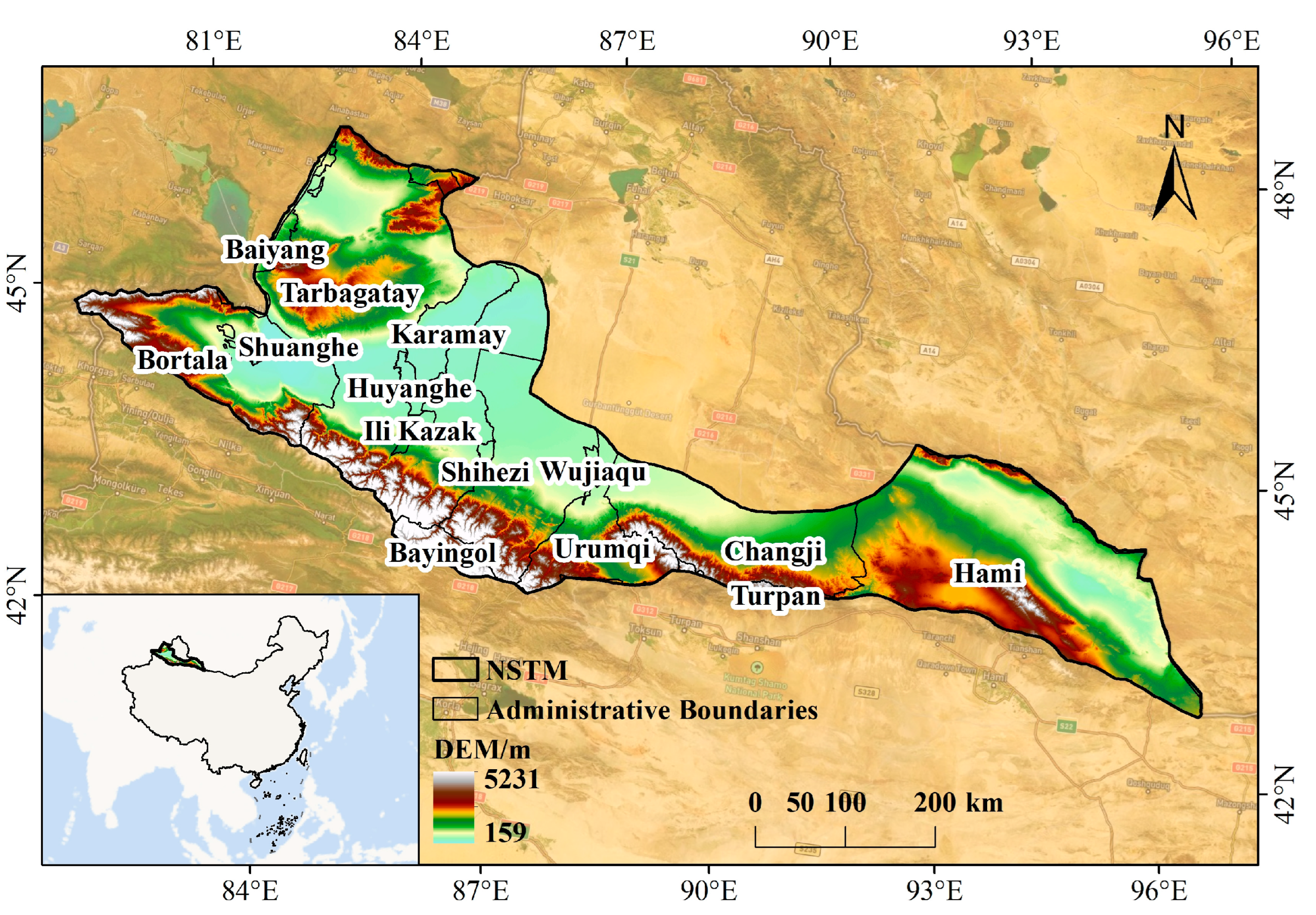
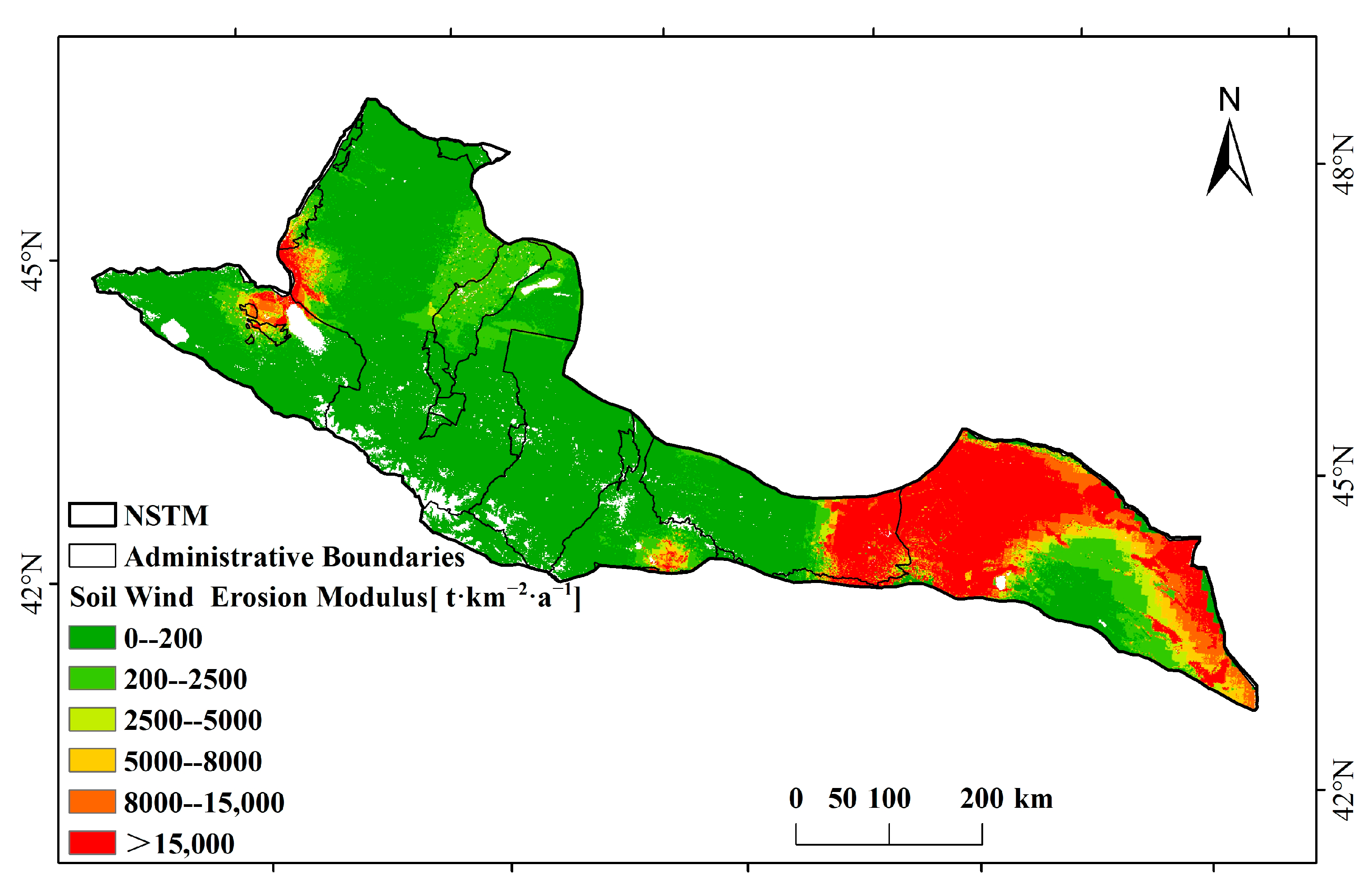
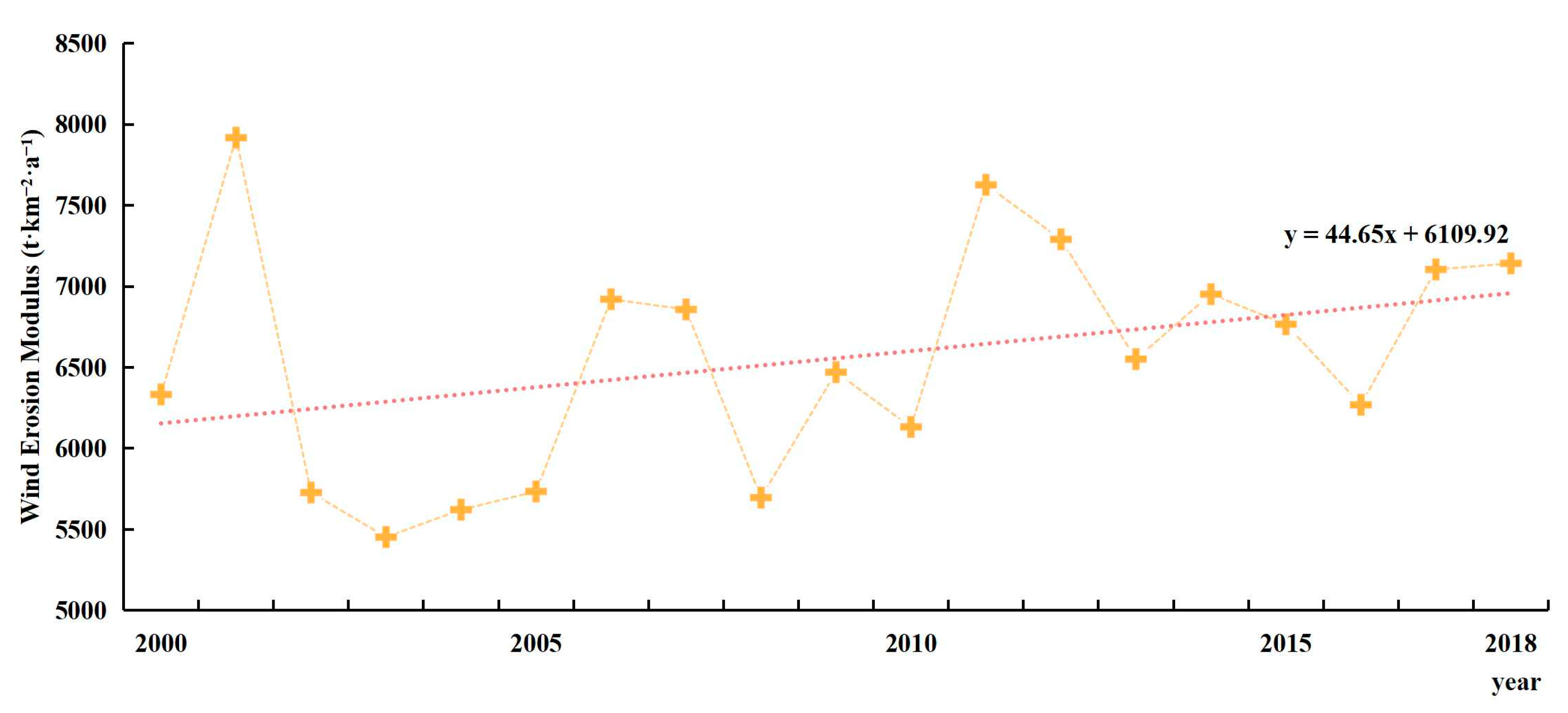
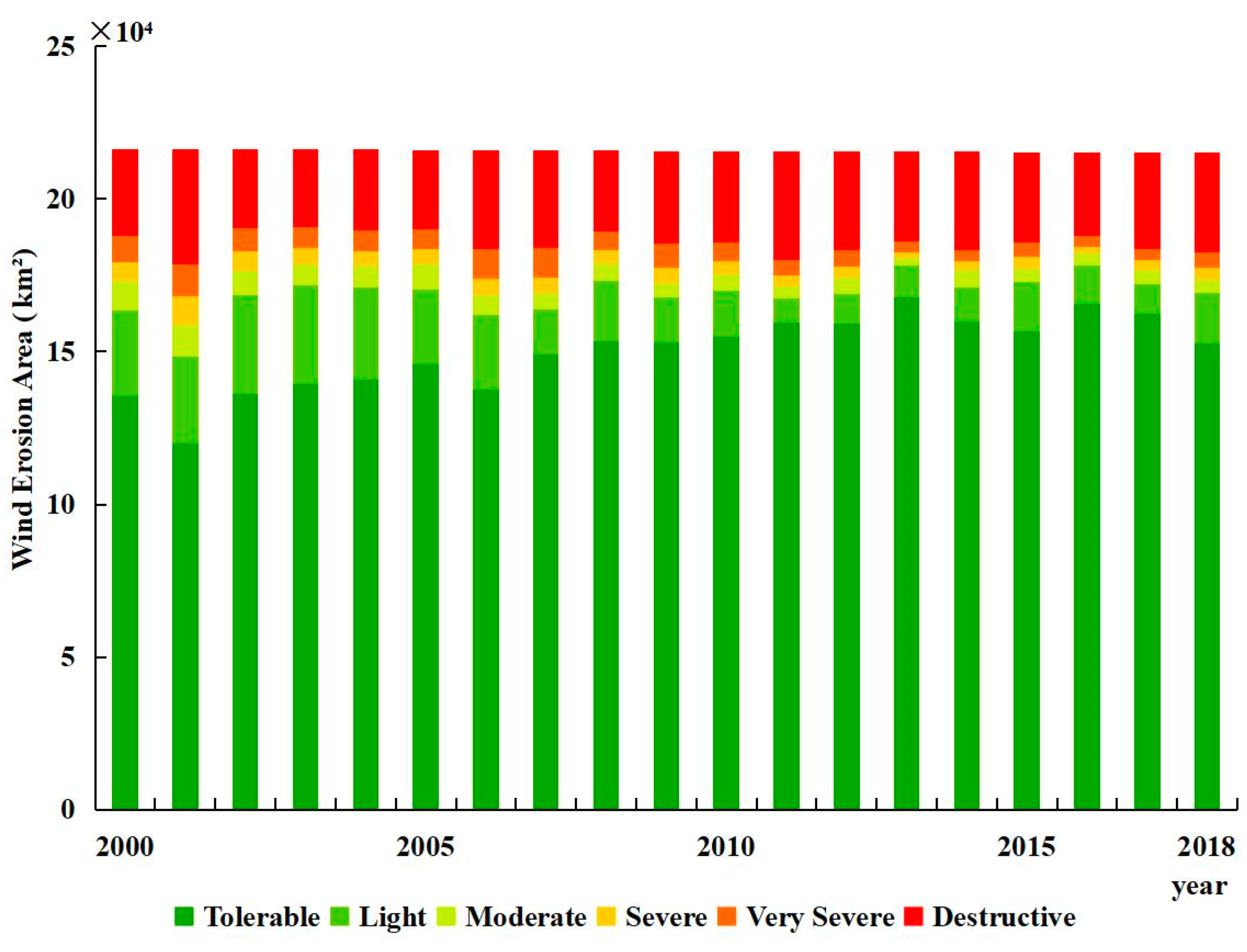

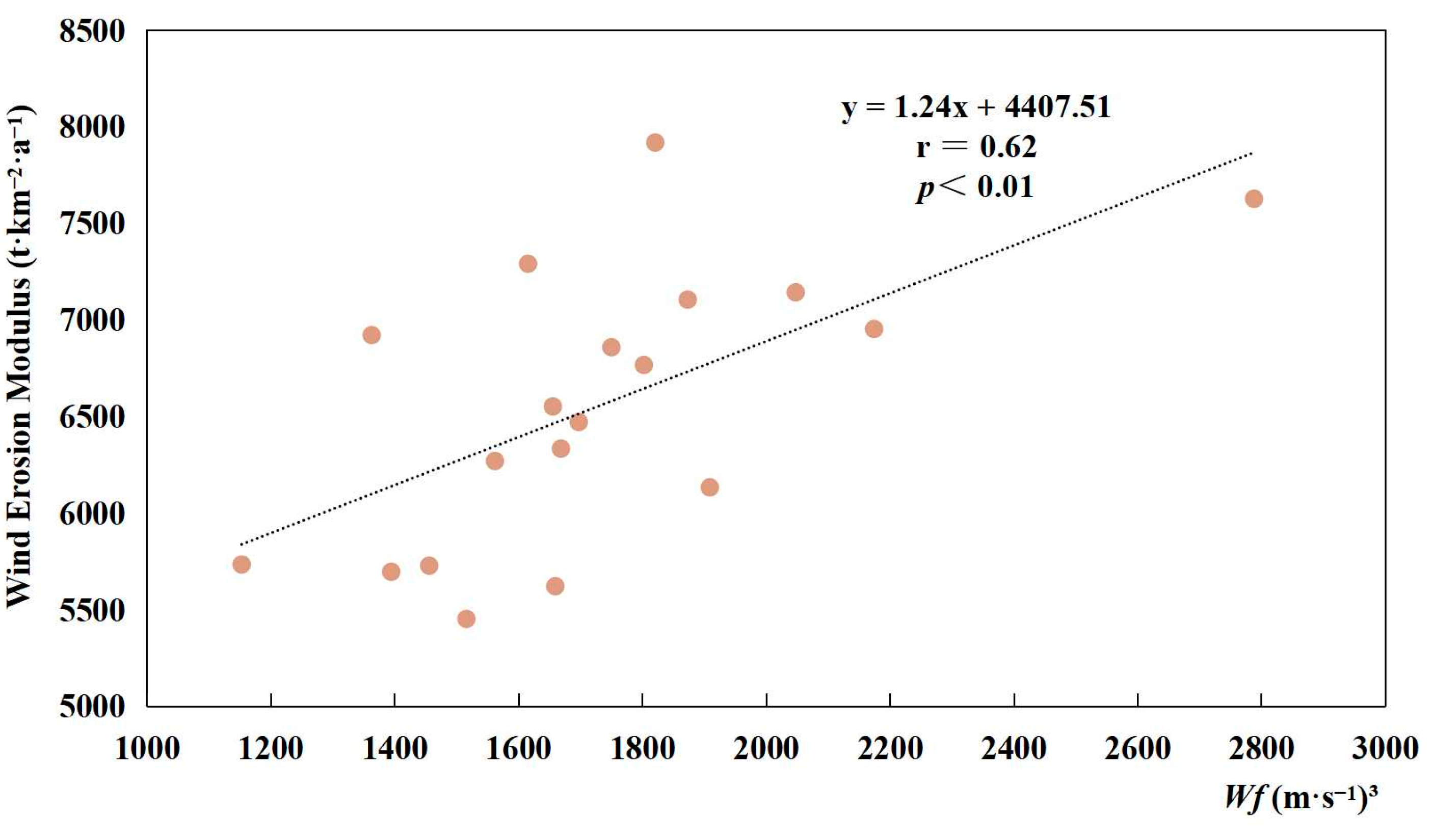
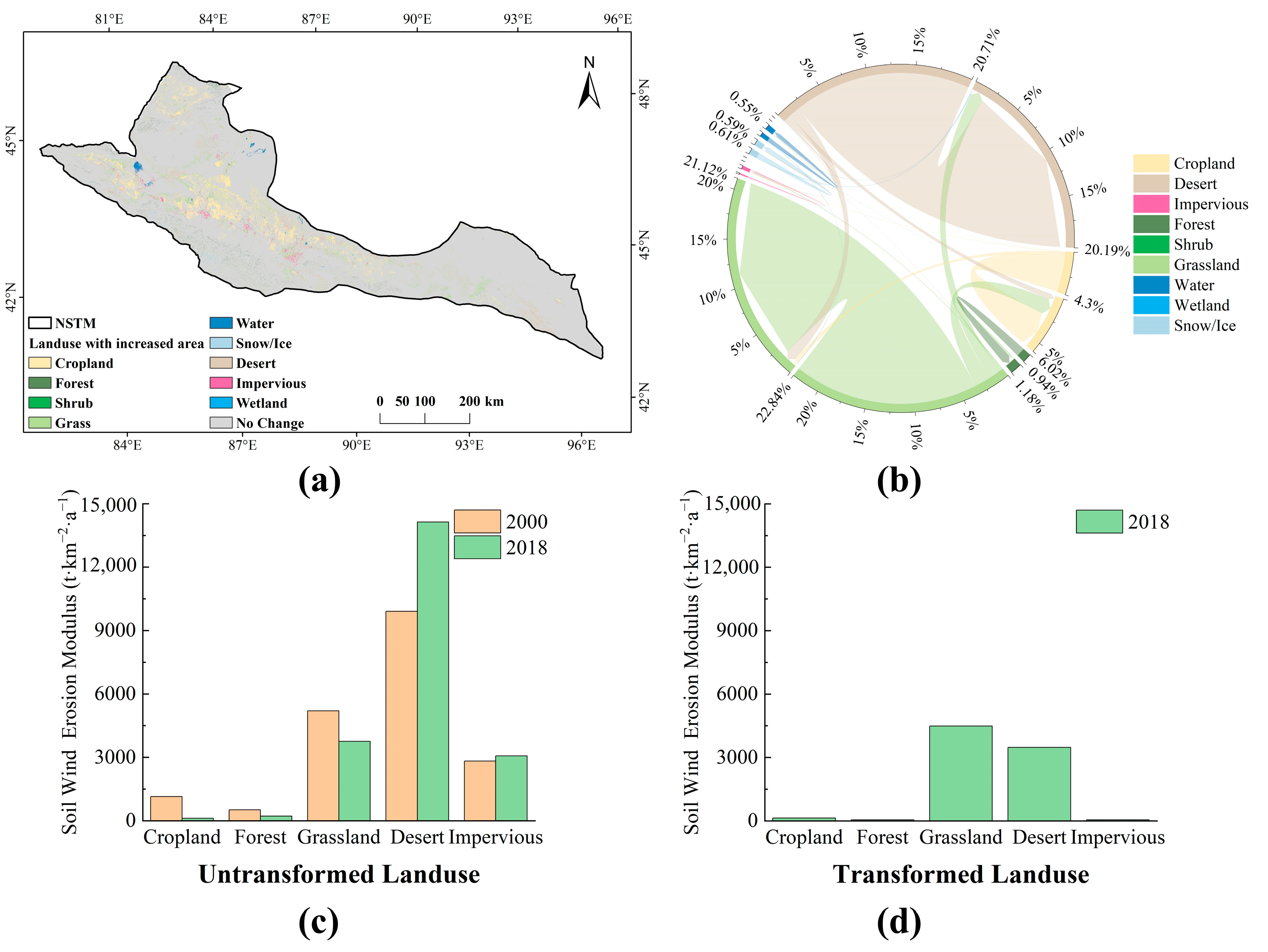
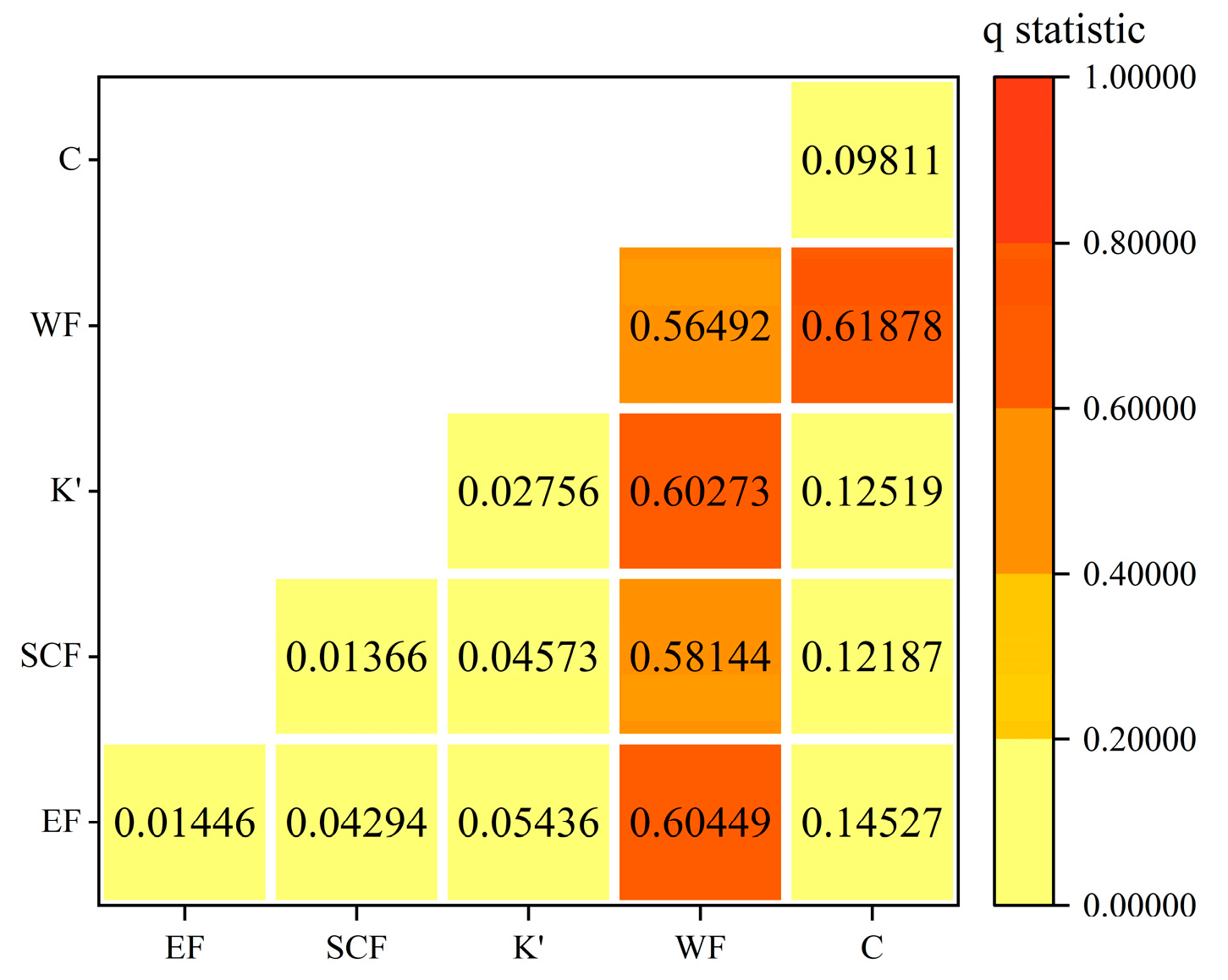
| Data Types | Temporal Resolution | Spatial Resolution | Source |
|---|---|---|---|
| Wind speed | 2000–2018 | 10 km | DOI: 10.11888/AtmosphericPhysics.tpe.249369.file [49] |
| Precipitation | 2000–2018 | 10 km | DOI: 10.11888/AtmosphericPhysics.tpe.249369.file [49] |
| Potential evapotranspiration | 2000–2018 | 1 km | DOI: 10.11866/db.loess.2021.001 [50] |
| Snow depth | 2000–2018 | 27.5 km | DOI: 10.11888/Geogra.tpdc.270194 [51] |
| Soil data | 2009 | 1 km | DOI: 10.12072/ncdc.westdc.db3647.2023 [52] |
| NDVI | 2000–2018 | 0.25 km | DOI: 10.12078/2018060602 [53] |
| Land use | 2000–2018 | 0.03 km | DOI: 10.5281/zenodo.5816591 [54] |
| Classification | Vegetation Coverage (%) | Soil Wind Erosion Thickness (mm/a) | Soil Wind Erosion Modulus [t·km−2·a−1] |
|---|---|---|---|
| Tolerable | >70 | <2 | <200 |
| Light | 50–70 | 2–10 | 200–2500 |
| Moderate | 30–50 | 10–25 | 2500–5000 |
| Severe | 10–30 | 25–50 | 5000–8000 |
| Very Severe | <10 | 50–100 | 8000–15,000 |
| Destructive | <10 | >100 | >15,000 |
| Interaction | Description |
|---|---|
| Weaken, nonlinear | |
| Weaken, uni-nonlinear | |
| Enhance, bi-nonlinear | |
| Independent | |
| Enhance, nonlinear |
Disclaimer/Publisher’s Note: The statements, opinions and data contained in all publications are solely those of the individual author(s) and contributor(s) and not of MDPI and/or the editor(s). MDPI and/or the editor(s) disclaim responsibility for any injury to people or property resulting from any ideas, methods, instructions or products referred to in the content. |
© 2024 by the authors. Licensee MDPI, Basel, Switzerland. This article is an open access article distributed under the terms and conditions of the Creative Commons Attribution (CC BY) license (https://creativecommons.org/licenses/by/4.0/).
Share and Cite
Wang, S.; Xu, X. Spatiotemporal Variation in Soil Wind Erosion in the Northern Slope of the Tianshan Mountains from 2000 to 2018. Land 2024, 13, 1604. https://doi.org/10.3390/land13101604
Wang S, Xu X. Spatiotemporal Variation in Soil Wind Erosion in the Northern Slope of the Tianshan Mountains from 2000 to 2018. Land. 2024; 13(10):1604. https://doi.org/10.3390/land13101604
Chicago/Turabian StyleWang, Shiyu, and Ximeng Xu. 2024. "Spatiotemporal Variation in Soil Wind Erosion in the Northern Slope of the Tianshan Mountains from 2000 to 2018" Land 13, no. 10: 1604. https://doi.org/10.3390/land13101604
APA StyleWang, S., & Xu, X. (2024). Spatiotemporal Variation in Soil Wind Erosion in the Northern Slope of the Tianshan Mountains from 2000 to 2018. Land, 13(10), 1604. https://doi.org/10.3390/land13101604






